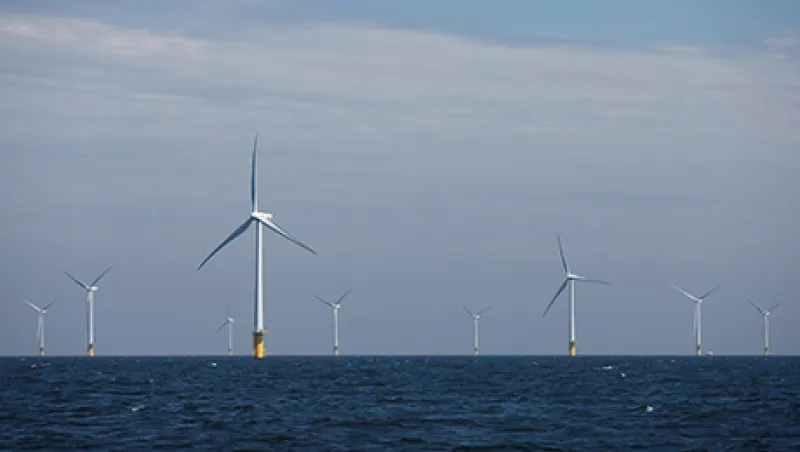When yield cos first hit the U.S. renewable energy equities market a year ago, Juno Beach, Florida–headquartered NextEra Energy didn’t rush to develop its own version of the new structure, even as it was publicly considering the idea. Instead, NextEra spent many of the ensuing months in what CFO Moray Dewhurst calls its “Hamlet phase,” asking, “To yield co, or not to yield co?”
“We were really trying to assure ourselves that we weren’t looking at something that’s just a short-term fad,” says Dewhurst, whose company is the largest generator of wind and solar energy in North America.
After long deliberations, NextEra answered its Shakespearean quandary in the affirmative. Investors have liked what they’ve seen. NextEra’s yield co, NextEra Energy Partners, went public on June 27 at $25 a share, increased from an original price of $19 to $21 a share because of strong investor demand. The IPO netted proceeds of about $440 million. Shares of the NextEra yield co have since soared, closing at more than $35 apiece on July 8.
Yield cos have wide, immediate appeal for investors. These publicly traded companies are created by their parent firms to house a collection of high-yielding power generation assets — often in renewable energy, because of the tax benefits. The income is distributed to investors as dividend payments, whose growth is guaranteed for a certain period — typically three to five years — as the parent company designates projects of its own to annex to the yield co to fuel that growth. In many ways, the yield co is the utility industry’s answer to the master limited partnership or real estate investment trust, which utilities can’t form because of regulatory constraints.
“This is a natural but pretty significant evolution in the types of investment opportunities that are available in the renewable energy space,” says Charles Park, member of the equity capital markets group at Goldman Sachs Group in New York. “If you think about what renewable energy has generally been as an asset class, it’s been high-growth, technology-oriented, sometimes high-risk equity investment opportunities. But yield cos and the assets in them are significantly derisked and have very highly visible cash flow.” Yield cos appeal to both income-oriented investors, especially in the present low-yield environment, and fixed-income investors, who say they’re able to get comfortable with the equity investment because of the hard assets connected to it and the fact that it pays a regular dividend.
Yet the novelty of the investment vehicle may, however, be a reason to pause and slow down a bit. When NextEra began considering its yield co, the structure had been introduced to the U.S. market just months earlier, in July 2013, by NRG Energy, a retail and wholesale electricity distributor and generator with headquarters in Houston and West Windsor Township, New Jersey, near Princeton.
“Yield cos are still very new,” says Swami Venkataraman, a senior credit officer at Moody’s Corp. “We don’t know what kinds of financial policies these companies will follow, or how they will react to, say, capital market conditions no longer being as favorable as they are currently, or to the renewables investment tax credit expiring [at year-end] 2016, or renewable portfolio standards changing state to state.”
A March 20 report from Moody’s encourages investors to be cautious, warning about the potential difficulty of maintaining yield cos’ continued growth over the long term. There are only so many power generation projects to gobble up, the report explains, and dividend payments might place pressure on parent companies and could otherwise be used to pay down debt or reinvest in other businesses.
Still, excitement around the possibilities for the yield co remains high. Besides NextEra, other energy companies that have spun out yield cos over the past year include Spanish renewable energy group Abengoa, Canada’s TransAlta, San Francisco–based wind power project operator Pattern Energy Group and, of course, the firm that started the trend, NRG Energy. And just this week TerraForm Power, a Beltsville, Maryland–based yield co created from assets of solar company SunEdison, filed an amended S-1 with the Securities and Exchange Commission that prices its IPO at as much as $21 a share, raising a maximum of $485 million before fees.
Mike Gordon, CEO of Joule Assets, a Bedford Hills, New York–based financing solutions company, believes the structure can be adapted to the energy efficiency sector. In mid-June Joule announced strategic financing partnerships for ten energy efficiency contracting firms — a setup Gordon thinks of as the private equity version of the yield co. Gordon says that so far he’s seen interest in the partnerships from hedge fund managers and private equity managers — both within and outside of the energy sector. He hasn’t seen a lot of interest from institutional investors, but he believes that could soon change.
“Institutional investors want to do a much deeper dive on the diligence,” he explains. “They’re saying, ‘We want to do this when we see a track record with a little more depth.’”
Get more on equities.






